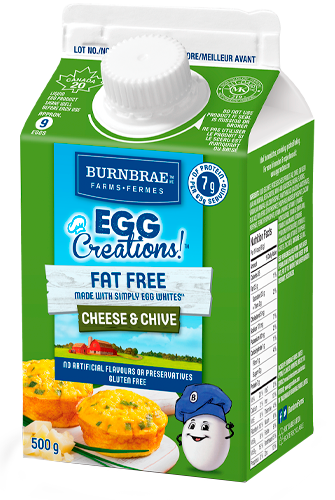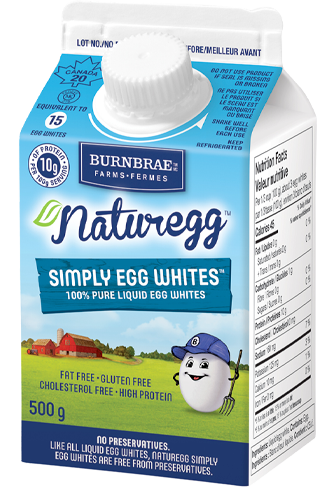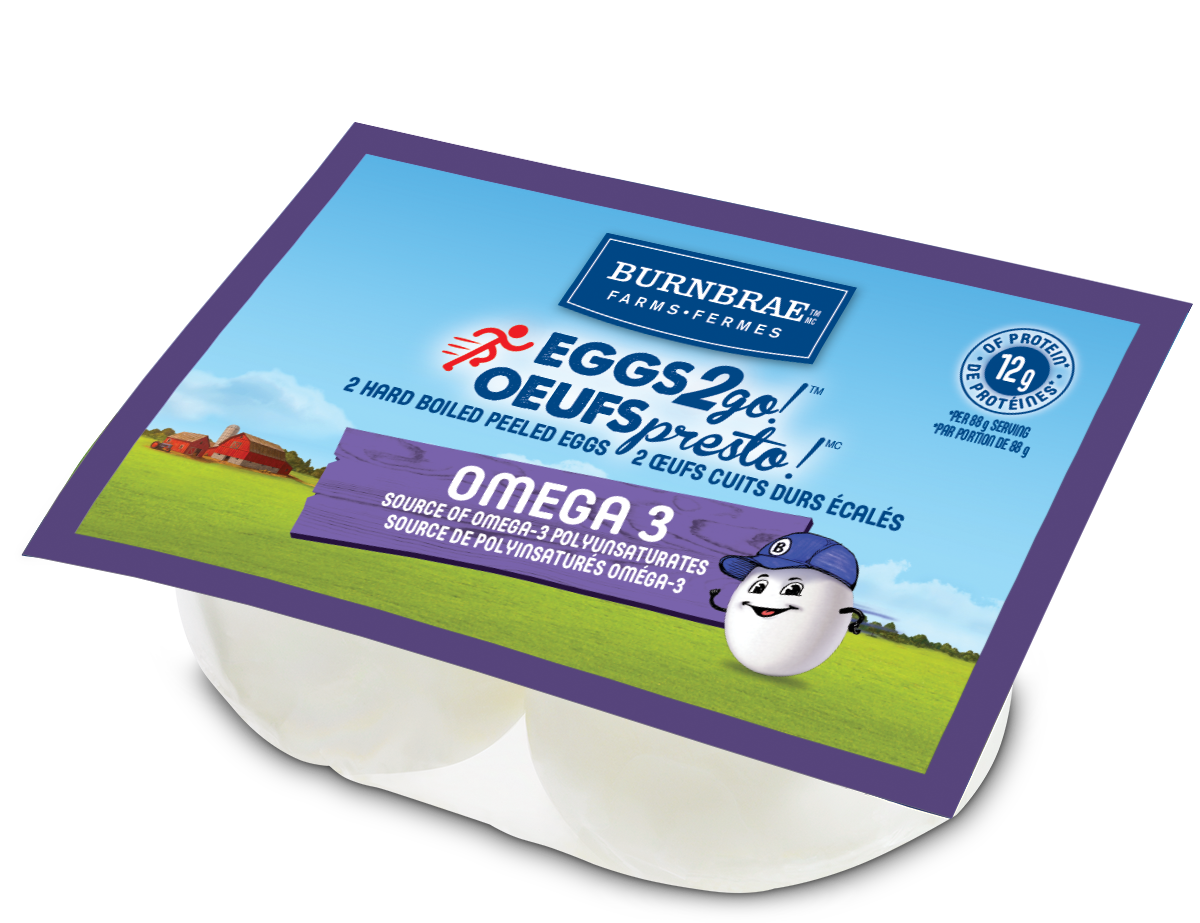Egg Facts
The most popular breed for egg production in Canada today is the White Leghorn - a small, light bird that lays far more eggs than its ancestors. Each stage of the hen's development cycle requires specialized care and attention. Chicks are hatched at hatcheries, raised in pullet barns for about 19 weeks and then transferred to the laying hen barn for their egg production life. At Burnbrae Farms our hen breeds are Leghorn or Rhode Island Red.
The average laying hen produces more than 320 eggs a year. Hens begin egg production at five to six months (19 weeks) of age and continue to lay for at least 12 months.
Eggs automatically roll out for collection and are gathered twice a day. They are then packed and refrigerated on the farm, ready for delivery to the grading station. By having different flocks of hens at different ages, egg producers have a steady supply of eggs to market and a stable year-round income.
Proper lighting, a well-balanced diet, fresh water and comfortable surroundings are essential for hen health and production. A hen's diet consists of grains, proteins, vitamins, minerals and plenty of fresh water.
Agriculture and Agri-Food Canada regulations define three quality grades that apply to eggs for sale to customers. These are:
- Grade A - sold at retail markets for household use
- Grade B - used mostly in bakeries
- Grade C - sent to egg breakers for processing
Only Grade A eggs are sized. They are sized according to the weight of each egg. Grade A small, medium, large and extra large. Agriculture and Agri-Food Canada inspectors monitor graded eggs to make sure they pass rigid standards. Obviously this weight includes the shell. Nutrition information in Canada is based on the large egg without the shell or a 50g serving.
- EXTRA LARGE - at least 64 g
- LARGE - at least 56 g
- MEDIUM - at least 49 g
- SMALL - at least 42 g
Yolk colour Is determined by the diet of the hen and does not affect the nutritive value or quality of the egg. The colour of the yolk is based on what the hen is fed and is measured using a Roche Yolk Colour Fan. Interestingly, hens in Western Canada are fed a more wheat-based diet and have lighter yolks. In the east, hens are fed more corn, and produce a slightly darker yolk. Plus, chicken feed contains carotenoids, which are natural plant pigments (found in carrots and leafy greens). The more carotenoids in the feed, and the more a hen eats, the darker the yolk. At Burnbrae Farms, our hens have free access to their feed, so it’s possible for them to over- or under-eat, which can affect yolk colour.
Both white and brown eggs have the same nutritional profile and are equally nourishing. Shell colour also does not affect flavour or cooking performance of the egg. The difference is in the breed of the hen laying the eggs. Brown-coloured Rhode Island Red hens lay brown eggs, while white-coloured White Leghorn lays white eggs. What changes the nutritional value of the egg is the hen’s feed. For example, include flax seed in her diet and she will put more omega-3 in her eggs.
Sometimes an egg white may have a greenish colour due to the presence of riboflavin (Vitamin B2). Carbon Dioxide in a very fresh egg may cause the white to be cloudy. In both cases, the egg is perfectly safe for consumption, and cooking performance is not affected.
Blood or "meat" spots are occasionally found on an egg yolk. Brown chickens tend to deposit blood spots more readily in their eggs, and therefore it is more likely to find these in brown eggs than white eggs. Today’s candling methods reveal most blood spots, and those eggs are removed, but even with electronic spotters it is impossible to catch all of them. The brown shell colour also makes the spots even harder to detect when they pass over the candling light (scan eggs for defects). These tiny spots are not harmful and are caused by the rupture of a blood vessel during the formation of the egg. If desired, the spot can be removed with the tip of a clean knife prior to cooking.
Burnbrae Farms and Agriculture and Agri-Food Canada (AAFC) work cooperatively at the producer, grader, restaurant and retail levels to ensure that our customers can have confidence in the safety and quality of eggs.
To encourage and promote the production and marketing of high quality shell eggs, the regional Egg Boards maintain an egg quality program for farmers prior to grading. In cooperation with Agriculture and Agri-Food Canada (AAFC), ungraded eggs from registered flocks are inspected for interior and exterior quality factors. If flocks are found to have low quality, the eggs are directed to the processing market. Farmers are educated to meet inspection standards for management and cleanliness. Testing programs at the farm monitor the barn environment to ensure standards are met. Burnbrae Farms is one of Canada's leading producers of eggs, and like all egg farmers cooperates fully with the AAFC to ensure that the eggs produced in our laying barns are of the best quality.
Burnbrae Farms is a Canadian company which gets most of its eggs from local farms across Canada.
On rare occasions, the available supply of eggs cannot meet the demand from our customers and on these occasions we will import eggs from the United States to ensure consumers have access to fresh eggs. This occurs a few times a year, generally in high demand times such as Easter, Thanksgiving and Christmas.
As in other industries such as poultry and dairy, Canada’s trade agreements with the US provides American egg producers with established access levels to Canadian markets. All egg grading stations across Canada, including those operated by Burnbrae Farms, utilize table egg imports as authorized by this agreement.
It is also important to note that our American suppliers are approved by the Canadian Food Inspection Agency (CFIA). Eggs imported from the US are packed in cartons which clearly display the USDA logo.
The trip from the hen to grading station to the retail shelf takes about 4-7 days. At the grading station, the eggs are washed and sanitized in a high-speed tunnel washer. Eggs are then candled by passing them over a strong light to remove any imperfect ones. Legislation ensures that all eggs sold in retail stores and restaurants must be graded at a station which conforms to rigorous federal standards. A Canadian Grade A egg must have a thick white and well-centered yolk, a very small air cell and a clean, sound shell. Burnbrae Farms has seven grading stations across Canada, one in Quebec, three in Ontario, one in Winnipeg, one in Calgary and one in British-Columbia.
Watch a video on our grading process below.
From the retail store to the table, the responsibility for maintaining egg wholesomeness is in the hands of consumers. Improper storage and handling of perishable food is the primary cause of food-borne illness. Controlling temperature is the key to preventing bacterial growth. To multiply, bacteria need food, moisture and above all, ideal temperature conditions. Below 4°C (40°F) and above 60°C (140°F) there is little or no growth. The secret to preventing bacteria from multiplying is to keep cold foods cold and hot foods hot. The spread of bacteria from one food to another (cross-contamination) is particularly dangerous because you are unaware of it. To avoid cross contamination, use clean utensils after each task. Never use the same utensils or equipment for raw foods and cooked foods unless they have been properly cleaned. Store raw and cooked foods separately.
Processed eggs are used in the food service industry and as an important ingredient in many foods, including mayonnaise, noodles and baked goods. Processed eggs are also used in pharmaceuticals, shampoo, pet foods and adhesives. At the processing plant, special machines break thousands of eggs per day. The yolk and whites may be pasteurized and processed or special components extracted. These products are sold around the world. The shells are recycled for use in livestock feed. In addition to providing processed eggs for food service and industrial use, Burnbrae Farms also produces three liquid egg products for retail. Naturegg Omega Pro and Simply Egg Whites are available at all major banners on a national basis. Burnbrae Farms has egg processing plants in Ontario, Manitoba and Quebec.
Here are some brief guidelines to help you with the easy and safe storage and handling of eggs in your home.
- Always store eggs in the refrigerator in their original cartons. This will keep them fresh and prevent them from absorbing odors from other foods in the refrigerator.
- Eggs are usually good if refrigerated for one to two weeks after purchase. The "sell by" date is 30 days after the pack date on the carton. They are good however 4 -5 weeks beyond the pack date.
- To tell if an egg is fresh, place it in a bowl of water. Fresh eggs will sink to the bottom and lie on the side. As the egg ages, the air cell in the large end becomes larger. As it does, the egg becomes more buoyant. An older egg will stand up in the bowl of water and a really old egg bobs along the top.
- A cloudy white is a sign of freshness. The cloudiness comes from the high carbon dioxide content of a freshly laid egg.
- Thick white is a sign of freshness. If there is a lot of jelly-like white, the egg is fresh. As it ages the white thins out.
- The stringy things on the sides of the yolk are the chalazae. These are twisted strands of white which act like nature's little seat belts holding the yolk securely and protected in the middle of the white. The more prominent the chalazae, the fresher the egg.
- Eggs are placed in their carton's large end up to keep the air cell in place and the yolk centered.
- To remove eggs that are stuck to cartons, try wetting the cartons to loosen them.
- If your hands are damp it is easier to handle eggs in the shell.
- If you drop an egg on the floor, sprinkle it heavily with salt for easier clean-up.
Our Products
You know how nutritious they are; now remind yourself of how delicious they are with our selection of eggs. Go ahead and crack a smile.
Hen Wellbeing
Our success depends on the care and attention that we provide to our hens. After all, a healthy hen is a quality-producing hen. But treating all our animals humanely isn’t just a business philosophy; it’s our moral commitment.
ViewHow We Produce
To bring you the best quality possible, a great deal of precision and care goes into the production of every Burnbrae egg.
View




